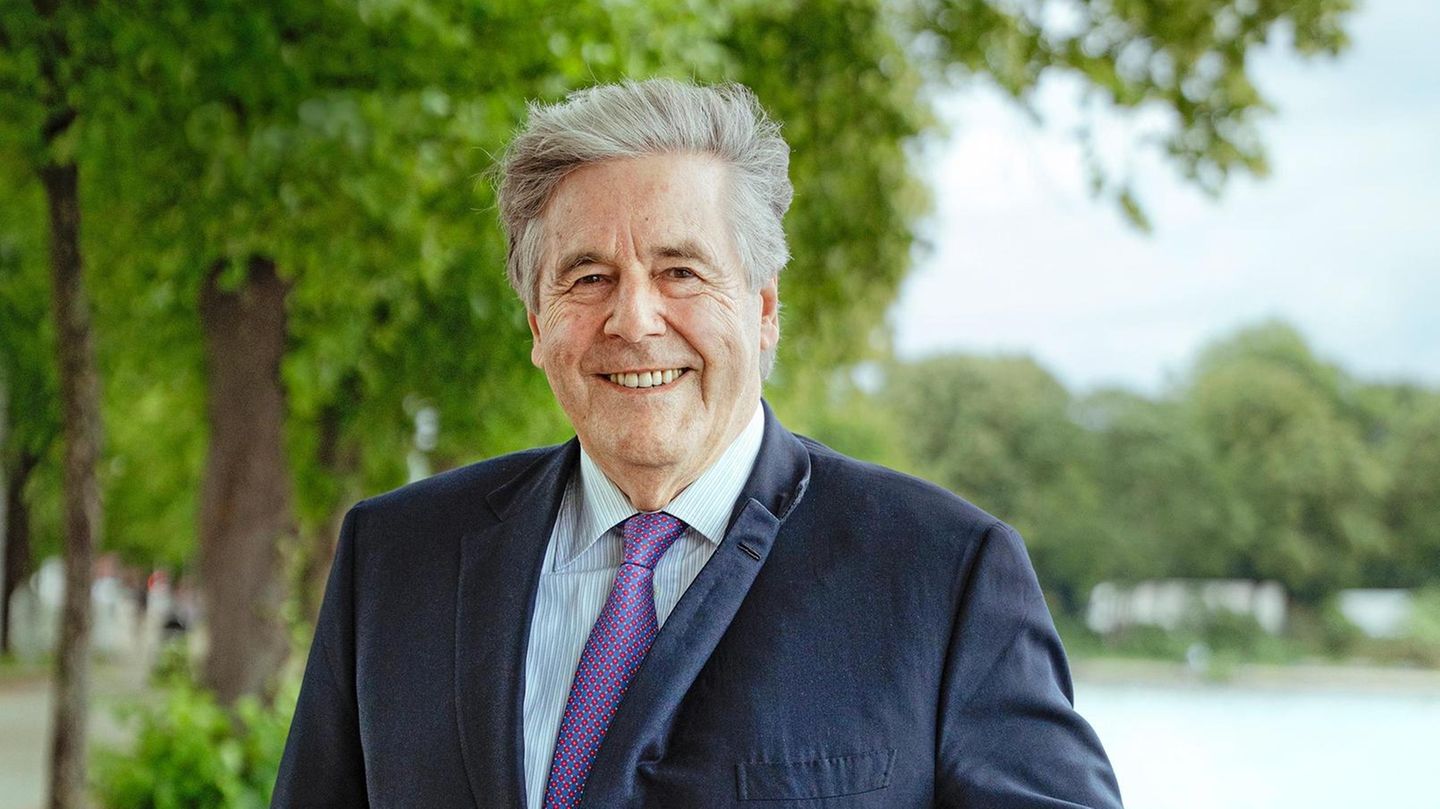Fears of a nuclear catastrophe around the Zaporizhia nuclear power plant occupied by Russia in the war zone in Ukraine are great. Now the situation threatens to escalate.
Moscow and Kiev accuse each other of preparing an attack on the Zaporizhia nuclear power plant in southern Ukraine. The Ukrainian General Staff wrote in its daily situation report about alleged explosive devices on the roof of the nuclear power plant.
In contrast, Kremlin spokesman Dmitry Peskov claims in Moscow that the danger of “sabotage by the Kiev regime is great.” Both sides warn of a catastrophe. Some questions and answers on the current situation around Europe’s largest nuclear power plant.
How is the situation in the nuclear power plant?
With six reactors, Europe’s largest nuclear power plant is located in the contested Zaporizhia region, which is partly controlled by Ukraine and partly by Russia. The reactors have been shut down since September 2022. Russian troops occupied the nuclear facility in the city of Enerhodar shortly after the war began in March last year. The warring parties repeatedly accused each other of shelling the facility. Warnings of a possible loss of control and nuclear catastrophe have been around for a long time.
In the face of global attention, Russia allowed inspections by the International Atomic Energy Agency (IAEA) last year. Since then, experts have been staying there to monitor the situation. The head of the Ukrainian nuclear supervisory authority, Oleh Korikow, told the German Press Agency in Kiev in mid-June that the situation was “extremely dangerous”. A total of 300 employees are still working in the nuclear power plant under Russian occupation.
What is the military situation around the nuclear power plant?
Ukraine has massively expanded its military activities in the Zaporizhia region as part of its major offensive to recapture its regions. The nuclear power plant should also be freed. The front line between Ukrainian and Russian troops is currently running about 50 kilometers east of the power plant town of Enerhodar, and there is also intense fighting there.
There have not been any major shifts in the front for a long time. However, Ukrainian units could also dare to advance across the expired Kakhovka reservoir. The distance to the other bank was less than five kilometers even before the Kachowka dam was destroyed a month ago. Russians and Ukrainians also repeatedly fought artillery duels across the Dnipro River near the nuclear power plant. There were also impacts on the power plant site.
How are warnings and threats to be evaluated?
According to Ukrainian and Russian sources, the situation is tense. The IAEA is also concerned. The adviser to the Russian nuclear operator Rosenergoatom, Renat Karchaa, claims that Kiev is planning a terrorist attack to raise international awareness of the war. Kiev’s aim is, under the pretext of a nuclear threat to all of Europe, to open the “legal floodgates” for direct intervention by NATO and the West in the war.
However, from the point of view of Carlo Masala, a political scientist at the University of the Federal Armed Forces in Munich, the Ukraine does not have the ability to blow up the nuclear power plant from the outside. Such a “blast is extremely complicated,” he told the dpa. Russia, on the other hand, could “create chaos” by detonating the nuclear power plant controlled by Moscow’s troops.
How is the cooling water situation after the dam destruction?
Because of the destroyed Kachowka dam, the power plant’s water supply is also affected. The supply channel can no longer supply water to the cooling pond. According to the IAEA, the water level in the pond is currently falling by around one centimeter every day. The water level is currently over 16 meters and guarantees the functioning of the cooling system for several weeks.
According to the Russian power plant administration, four units are in “cold operation” and another is being shut down for repairs. Block five, on the other hand, is still in “warm shutdown” and therefore needs stronger cooling measures. The Ukrainian operator Enerhoatom had ordered a “cold shutdown” because a complete failure of the cooling system, which was previously unlikely, could lead to a nuclear accident.
How big is the danger posed by the power plant?
The pressurized water reactors of Soviet design are protected by a thick layer of reinforced concrete. This should allow them to survive both the crash of small planes and internal explosions. This would also make serious damage from explosive devices or artillery fire very difficult.
However, the nuclear waste interim storage facility not far from the reactors is at risk from shelling. More than 170 concrete containers are in the open air and would hardly withstand an artillery attack. Radioactivity could be released if a container is hit. However, the consequences would be local.
Is Berlin preparing for a nuclear catastrophe?
The Federal Office for Radiation Protection (BfS) has been closely monitoring the situation at the Zaporizhia nuclear power plant since the beginning of the war, a spokeswoman said on request. According to the BfS, the combat operations, the power supply and the working conditions of the employees represent the greatest risk factors. In addition, everything must be done to ensure the cooling of the safety-relevant systems of the nuclear power plant.
Should there be a release of radioactivity in Ukraine, the consequences on site would be considerable, the BfS said. “For Germany, the radiological impact of a release in Ukraine would be limited.” Germany also remembers the catastrophe at the Chernobyl nuclear power plant north of Kiev, where a reactor exploded in 1986, back in Soviet times, triggering the largest radioactive accident in the history of the civilian use of nuclear energy.
In the past, the BfS had already dealt with the question of what effects could be expected on Germany if radioactivity was released in Ukrainian nuclear power plants. According to the information, it was investigated how radioactivity would spread. According to this, over a year in the past, the air masses only moved from the Ukraine to Germany in about 17 percent of the cases.
Due to the great distance between the Ukraine and Germany, it would take at least one to two days after a release of radioactive substances from a nuclear power plant in the Ukraine for radioactively contaminated air to reach Germany in most weather conditions.
In the worst case, values for food that are set in agriculture in Germany could also be exceeded. Then a control of feed and food would be necessary, possibly also a marketing ban for contaminated products. According to calculations by the BfS, it is not to be expected that further measures such as evacuation, staying in buildings or taking iodine tablets would be necessary to protect the population in Germany.
What is the attitude of the Atomic Energy Agency?
The UN authority has long warned of the consequences of an escalation. IAEA chief Rafael Grossi therefore pushed for the establishment of a nuclear safety and protection zone around the nuclear power plant in his contacts with Moscow and Kiev. For almost a year, several IAEA experts have been stationed in Zaporizhia to independently assess the security situation. “We’re trying to be as visible and effective as possible on the ground to prevent a nuclear accident,” Grossi said.
What does Ukraine want to achieve?
Nuclear supervisor Korikov in Kiev, like the Ukrainian government, is calling for international sanctions against Russia’s nuclear industry in order to increase pressure on Moscow to release the nuclear power plant. “In Europe, the opinion is widespread that without Russian fuel rods, but I can tell you that we have completely changed and can do without Russian technology. Nobody needs Russian nuclear technology,” Korikov told dpa. The nuclear power plant receives fuel rods from the USA.
Source: Stern
I have been working in the news industry for over 6 years, first as a reporter and now as an editor. I have covered politics extensively, and my work has appeared in major newspapers and online news outlets around the world. In addition to my writing, I also contribute regularly to 24 Hours World.




